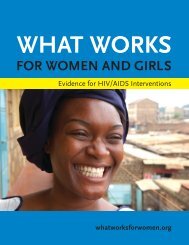Global Tuberculosis Report -- 2012.pdf
Global Tuberculosis Report -- 2012.pdf
Global Tuberculosis Report -- 2012.pdf
You also want an ePaper? Increase the reach of your titles
YUMPU automatically turns print PDFs into web optimized ePapers that Google loves.
BOX 4.1Frequencies of resistance to fluoroquinolones among MDR-TB casesFluoroquinolones represent the most powerful class of bactericidal second-line drugs for the treatment of MDR-TB. Patients with MDR-TBand additional resistance to fl uoroquinolones have a more serious form of disease compared with those with MDR-TB alone. Their diseaseis more diffi cult to treat, and risks evolving into XDR-TB and acquiring resistance to any of the second-line injectable agents.Monitoring resistance to fl uoroquinolones in MDR-TB patients is critical to predict the effi cacy of second-line treatment and possiblymodify the composition of the treatment regimen. Since 2007, WHO has collected surveillance data on cases of MDR-TB with additionalresistance to fl uoroquinolones. In most cases, only the compound most commonly used in the country is tested for susceptibility, usuallyofl oxacin, moxifl oxacin or levofl oxacin.A total of 62 countries and 3 territories reported representative data on the proportion of MDR-TB cases that had additional resistance tofl uoroquinolones. Combining their data, the proportion of MDR-TB cases with additional resistance to fl uoroquinolones was 14.5% (95%confi dence interval 11.6–17.4%), inclusive of cases with XDR-TB.FIGURE 4.5DST coverage among new cases and enrolment on MDR-TB treatment, compared with the targets in the<strong>Global</strong> Plan to Stop TB, 2011–2015. Lines indicate the planned targets, blue squares show the situation in 2009–2011and green circles the projected enrolments 2012–2015.25a. DST coverage among new bacteriologically-positive cases300 000b. Enrolment on MDR-TB treatment20250 000Percentage of cases1510Number of patients200 000150 000100 000550 00002009 2010 2011 2012 2013 2014 201502009 2010 2011 2012 2013 2014 20154.2.2 Notification of MDR-TB cases and enrolment ontreatmentThe suboptimal levels of coverage of DST in many countriesare one of the main reasons why the number ofpeople who are diagnosed with MDR-TB remains low.<strong>Global</strong>ly, just under 60 000 cases of MDR-TB were notifiedto WHO in 2011, mostly by European countries andSouth Africa (Table 4.2). This represented 19% of the310 000 (range, 220 000–400 000) cases of MDR-TB estimatedto exist among patients with pulmonary TB whowere notified in 2011. An additional 4500 rifampicintheworld – the proportion of cases tested was higher than20% among new cases in 10 of the 12 European countriesreporting data, and exceeded 50% among previouslytreated cases in six European countries. While data onDST were not available for new and previously treatedcases separately, overall 13% of TB cases were tested fordrug resistance in South Africa. Among non-Europeanhigh MDR-TB burden countries, testing for MDR-TBamong new cases was highest in China (2.6%); amongpreviously treated cases testing coverage was higherand reached 17% in the Philippines. India, the countryestimated to have the highest number of MDR-TB casesamong notified TB patients (Figure 4.6), reported no data.Among TB patients who were notified and confirmedto have MDR-TB in 2011, 23% were reported to havesecond-line DST for both fluoroquinolones and secondlineinjectable drugs, and coverage exceeded 90% inArmenia, Estonia, Georgia, Lithuania and Pakistan.South Africa accounted for most of the cases with secondlineDST data reported globally, as well as the high levelobserved in the African Region, which drops from 67% to9% when excluding this country. Otherwise, second-lineDST reports were available for 51% of cases in the EasternMediterranean Region, 40% in the Region of the Americasand 8–10% in the other regions.Progressive acquisition of drug resistance is a considerablerisk if TB patients are inadequately tested and treated(see Box 4.2). Increasing the coverage of diagnostic DST isurgently needed to improve the diagnosis of MDR-TB andXDR-TB, and requires strengthening laboratory capacityand the introduction of new rapid diagnostics (for furtherdetails, see Chapter 6).GLOBAL TUBERCULOSIS REPORT 2012 45
















